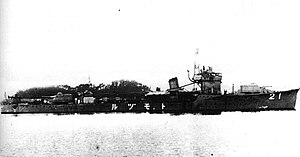Japanese torpedo boat Tomozuru

Tomozuru in 1934
|
|
| History | |
|---|---|
|
|
|
| Name: | Tomozuru |
| Launched: | 1 October 1933 |
| Completed: | 24 February 1934 |
| Fate: | Sunk 24 March 1945 |
| General characteristics as built | |
| Class and type: | Chidori-class torpedo boat |
| Displacement: |
|
| Length: | 82 m (269 ft 0 in) |
| Beam: | 7.4 m (24 ft 3 in) |
| Draught: | 2.5 m (8 ft 2 in) |
| Speed: | 30 knots (35 mph; 56 km/h) |
| Complement: | 113 |
| Armament: |
|
| General characteristics after rebuilding | |
| Displacement: |
|
| Draft: | 2.38 m (7 ft 10 in) |
| Speed: | 28.0 knots (32.2 mph; 51.9 km/h) |
| Range: | 1,600 nmi (3,000 km) at 14 kn (16 mph; 26 km/h) |
| Armament: |
|
Tomozuru (友鶴?) was one of four Chidori-class torpedo boats of the Imperial Japanese Navy (IJN). It capsized in a storm on 12 March 1934, shortly after its completion. This incident forced the IJN to review the stability of all recently completed, under construction and planned ships. It was salvaged and put back into service after extensive modifications. During World War II, the Tomozuru fought in the Battle of the Philippines and in the Dutch East Indies campaign as an escort, and it continued to play that role for the rest of the war.
In February 1934, Tomozuru joined the 21st Torpedo Flotilla at Sasebo.
The instability of the Chidoris arose from Japanese efforts to circumvent the various naval treaties. They had designed small vessels of around 600 tons, but with the weaponry of a destroyer of twice the displacement. Weight had been saved by lighter construction but gun systems remained complex and heavy. After the launch of the lead ship, its high centre of gravity - even higher than feared - had been noted and efforts made to remedy this. High-speed sea trials showed it to be unstable, however, and further efforts were made to rectify the problem by adding bulges to the hull. Eventually Chidori satisfied the examiners and it was commissioned and the construction of the class, including Tomozuru, proceeded. At the time of its loss, Tomozuru was low on consumables such as fuel or water that would have ballasted it and lowered its centre of gravity. On the other hand, munitions were fully loaded, so the situation was significantly worse than on its sea trials.
The cause of Tomozuru capsizing was a low metacentric height. The IJN established a committee and inspected the stability of all vessels. As a result of the inspection, the IJN discovered a lack of rolling performance, among others, in the following vessels:
...
Wikipedia
